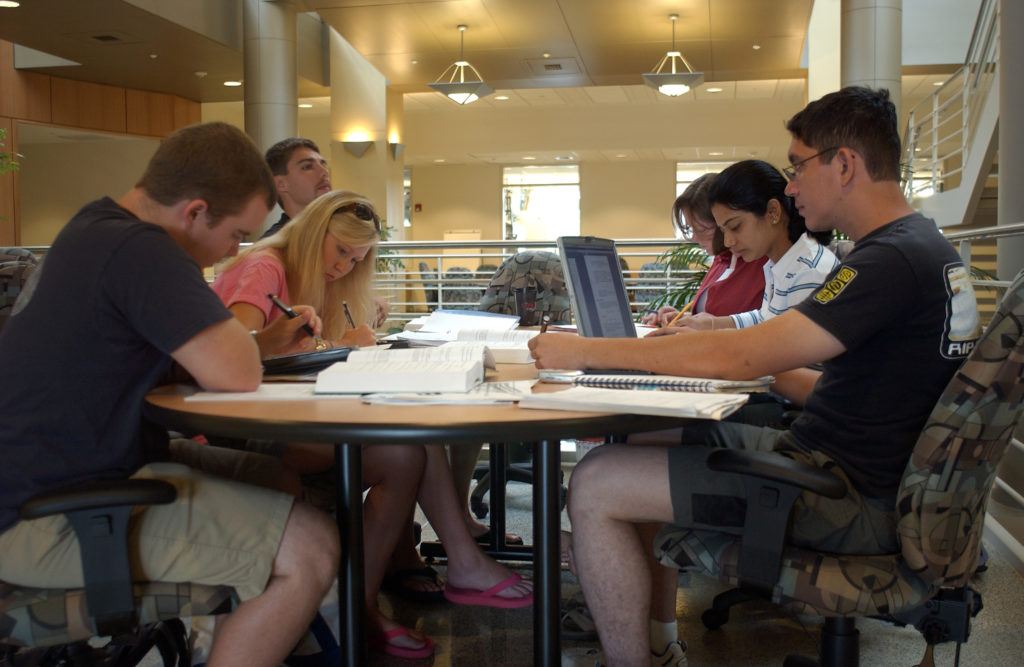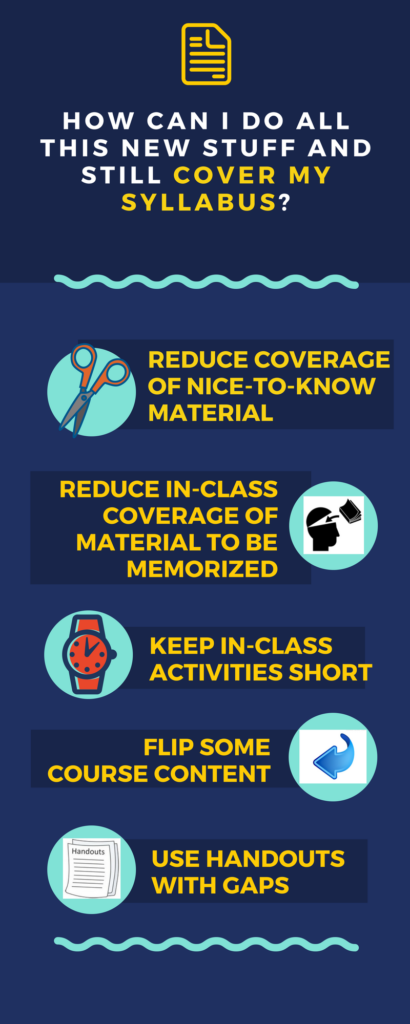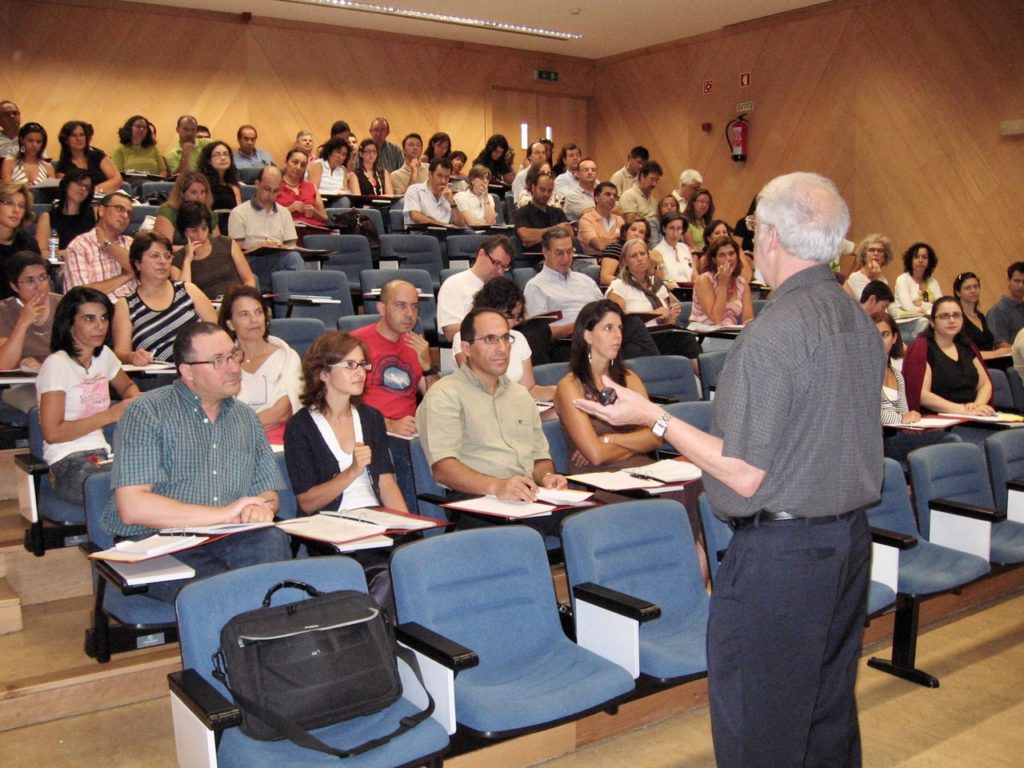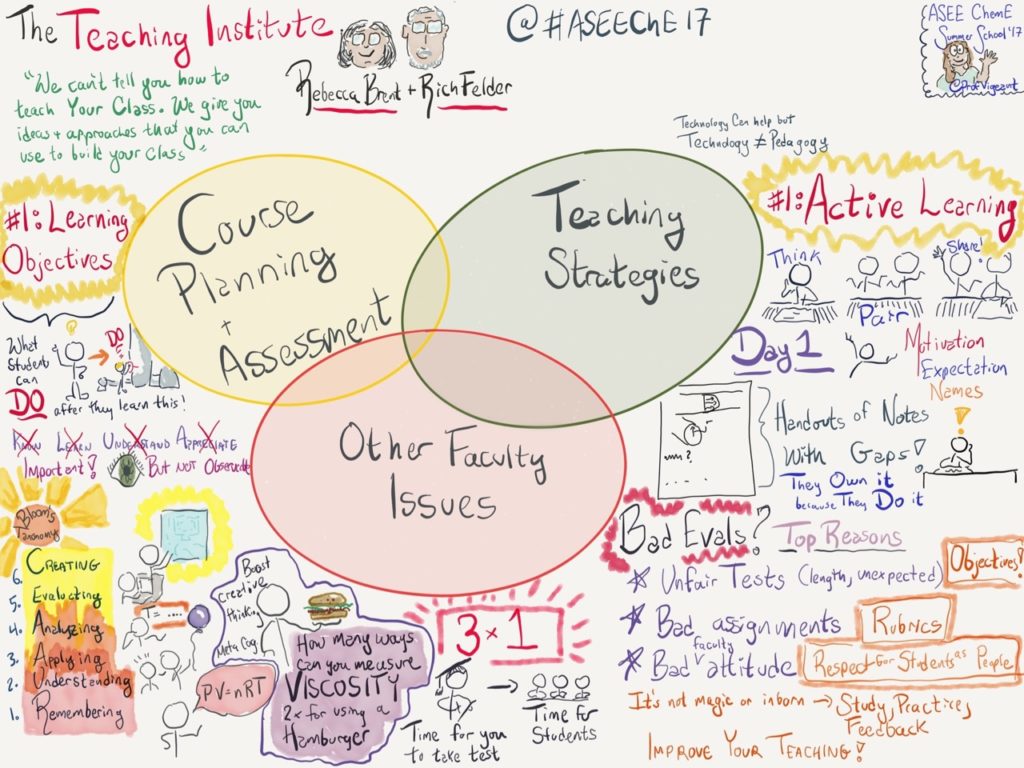 When learner-centered teaching (LCT) methods, such as active, cooperative, and problem-based learning are well done, strong student resistance is uncommon and usually short-lived when it occurs. Here are some strategies that minimize or eliminate it [DeMonbrun et al., 2017; Felder & Brent , 1996; Nguyen et al., 2017; Seidel & Tanner, 2013; Tolman & Kremling, 2016; Weimer, 2013].
When learner-centered teaching (LCT) methods, such as active, cooperative, and problem-based learning are well done, strong student resistance is uncommon and usually short-lived when it occurs. Here are some strategies that minimize or eliminate it [DeMonbrun et al., 2017; Felder & Brent , 1996; Nguyen et al., 2017; Seidel & Tanner, 2013; Tolman & Kremling, 2016; Weimer, 2013].
- Ease into LCT.
If you’re new to active learning, start with one or two brief (10 s – 3 min) active learning exercises in each class session, and continue doing it until both the students and you become accustomed to the approach. Gradually increase the frequency of activities until you get to a level you’re happy with. After a semester or two of that, you may choose to move into other LCT methods such as inquiry-based and cooperative learning. When you feel comfortable with those approaches, if you want to do full-scale problem-based learning (nothing says you have to), go for it. If you jump directly into PBL without getting experience with gentler methods, the student resistance could overwhelm you and you might decide never to try LCT again, which would be a loss for both you and them.
- Before you start to use an LCT method, learn about it.
All LCT methods have pitfalls—common mistakes instructors make that limit the effectiveness of the methods and aggravate student resistance to them. The education literature offers lots of guidance on what those mistakes are and how to avoid them. Weimer [2013] provides an excellent general discussion, active learning is addressed by Felder & Brent [2016, pp. 122–127, 243–244], cooperative learning by Felder & Brent [2016, Ch. 11] and Oakley et al. [2007], and inductive teaching and learning by Prince & Felder [2006, 2007]. Find out about the mistakes before you make them rather than learning about them by trial-and-error.
- Form good relations with the students and motivate them to learn, starting Day 1.
Felder & Brent [2016, pp. 52–62] suggest a number of techniques for the first week of a course that serve those purposes. They include learning as many of your students’ names as possible, setting up mechanisms for easy and effective communication with them, and helping them understand the connections between your course and their interests and career goals. If students believe that you care about them and their learning and they feel motivated to learn in your course, they’ll be less likely to rebel against a teaching practice they don’t like at first [Weimer, 2013].
- Explain what you’re doing, why, and what’s in it for the students.
When you start doing something in a class that makes students more responsible for their own learning than they are used to, they are likely to push back, thinking that you are either avoiding your teaching obligations or running an experiment with them as the guinea pigs. Explaining what you’ll be doing and how it’s in their interests before you start doing it can lower their resistance long enough for them to see that you’re telling them the truth. Part of the explanation should be an offer to show them research demonstrating that students taught the way you’ll be teaching get higher grades. See Felder (n.d.) for an illustrative Day 1 sermonette that introduces active learning to a class and cites Freeman et al. (2014) for the research, and Felder & Brent (2016, pp. 243–244) for sermonettes aimed at students working on assigned project teams.
- Model and give practice in unfamiliar methods.
If you assign students to do high-level analytical or critical or creative thinking or technical writing or oral reporting, or to tackle a problem before they’ve been taught how (which is what happens in inductive teaching and learning), there’s a good chance that many of them won’t understand what you’re looking for. Their frustration can be intense when that happens, and resistance is a likely outcome.
To avoid it, first show some concrete examples of the kind of thinking you’re looking for, and then have the students critique other examples and try to do similar things in active learning exercises. Then, and only then, give them assignments and tests on the targeted skills. For some concrete examples of tasks that call for a variety of high-level skills, see Felder & Brent [2016, Ch. 9–10].
- Interact with students while they are engaged in LCT activities.
If your students are working on activities in class that take more than a few seconds, circulate among them and be ready to provide help and encouragement. If several students raise a question or point of confusion, share your response with all of them, either in class, by email, or by posting it on the course website or a discussion forum. Encourage students to contact you in live or virtual office hours.
- After several weeks, survey students regarding their LCT experience.
After enough time has elapsed for the students to get used to an LCT method (say, 2–4 weeks), given them an anonymous survey that asks whether they believe the method is helping them learn, hindering their learning, or having little effect on their learning, and solicit their comments about what they do and don’t like about the method.
A probable outcome is that many students will believe that the LCT method is helping them learn, many others will be neutral, and a handful will think they are learning less than they would if you taught traditionally. If that is indeed what happens, report the results in the next class session. As a rule, students who are hostile to LCT after a few weeks of it believe that they are the vanguard of a mass movement. When they discover that most of their classmates are either enthusiastic about it or could take it or leave it, their overt resistance usually fades away. On the other hand, if the survey shows that many students are still hostile to LCT, look back at the literature, see if you were violating any recommendations for how to do it, and look for patterns in the students’ comments about what in particular bothers them about it. Decide what, if anything, you’ll change in the future, and announce it in the next class session.
- Learn from your first try, and try again.
The first time you teach a course traditionally, you can be sure that you won’t get it right. You’ll learn from that experience, make changes, and the course will be much better the second time. By the third time, it will start to look like what you initially had in mind.
It’s no different with learner-centered teaching. Give it your best shot the first time, figure out how you could have done it better, and do it that way the second time. It may take longer than three iterations to get it where you want it, especially with a challenging method such as problem-based learning, but if you have patience and an open mind you’ll eventually start to see the learning benefits that the LCT literature promises.
References
DeMonbrun, M., Finelli, C.J., Prince, M., Borrego, M., Shekhar, P., Henderson, C., and Waters, C. (2017). Creating an instrument to measure student response to instructional practices. Journal of Engineering Education, 106 (2), 273–298.
Felder, R.M., and Brent, R. (1996). “Navigating the bumpy road to student–centered instruction.” College Teaching, 44 (2), 43–47.
Felder, R.M., and Brent, R. (2016). Teaching and learning STEM: A practical guide. San Francisco: Jossey-Bass.
Felder, R.M. (n.d.). Sell active learning to your students before doing it [Blog post].
Nguyen, K., Husman, J., Borrego, M., Shekhar, P., Prince, M., DeMonbrun, M., Finelli, C. Henderson, C., and Waters, C. (2017). Students’ expectations, types of instruction, and instructor strategies predicting student response to active learning. International Journal of Engineering Education, 33 (1A), 2–18.
Oakley, B.A., Hanna, D.M., Kuzmyn, Z., and Felder, R.M. (2007). “Best practices involving teamwork in the classroom: Results from a survey of 6435 engineering student respondents. IEEE Transactions in Education, 50(3), 266–272 (2007).
Prince, M.J., and Felder, R.M. (2006). Inductive teaching and learning methods: Definitions, comparisons, and research bases. J. Engr. Education, 95(2), 123–138 (2006).
Prince, M.J., and Felder, R.M. (2007). The many faces of inductive teaching and learning. J. Coll. Sci. Teaching, 36(5), 14–20.
Seidel, S.B., and Tanner, K.D. (2013). “What if students revolt?”—Considering Student Resistance: Origins, Options, and Opportunities for Investigation. CBE Life Sci Educ, 12(4), 586–595.
Tolman, A.O., and Kremling, A. (2016). Why students resist learning: A practical model for understanding and helping students. Sterling, VA: Stylus Publishing.
Weimer, M. (2013). Learner-centered teaching: Five key changes to practice (2nd ed.). San Francisco: Jossey-Bass.
Please follow and like us:
 I just read a terrific piece, Ohm’s Law Is a Lie, by Kundan Nepal and Greg Mowry in this month’s ASEE Prism. The piece was sponsored by KEEN Engineering Unleashed and describes the Question Formulation Technique (QFT), an inquiry approach developed by the Right Question Institute. The authors describe using the QFT with electrical engineering students as they presented the provocative statement, “Ohm’s Law is a lie” to the class. The students then generated in groups their own questions to drive their learning including: Why is Ohm’s Law commonly accepted if it is false? What is a law in science? What would make this one a lie, and how do we know whether or not it is? Students then refined and prioritized the questions in preparation for doing their own research and presentations on the topic. A final step was having students reflect on the process of scientific validation.
I just read a terrific piece, Ohm’s Law Is a Lie, by Kundan Nepal and Greg Mowry in this month’s ASEE Prism. The piece was sponsored by KEEN Engineering Unleashed and describes the Question Formulation Technique (QFT), an inquiry approach developed by the Right Question Institute. The authors describe using the QFT with electrical engineering students as they presented the provocative statement, “Ohm’s Law is a lie” to the class. The students then generated in groups their own questions to drive their learning including: Why is Ohm’s Law commonly accepted if it is false? What is a law in science? What would make this one a lie, and how do we know whether or not it is? Students then refined and prioritized the questions in preparation for doing their own research and presentations on the topic. A final step was having students reflect on the process of scientific validation.







